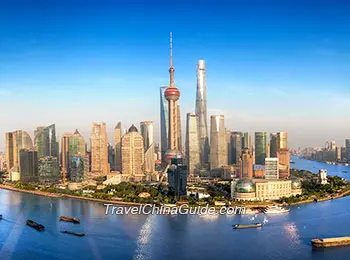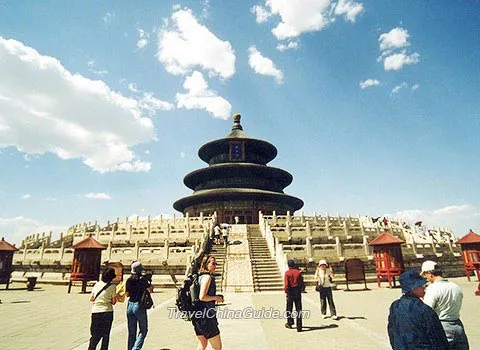Home /
Top 10 Biggest Cities in China by Area
If someone is asked to name the biggest cities in China, they would probably come up with Beijing, Shanghai, Guangzhou, Shenzhen etc. Unexpectedly, ranked by area, they are all excluded from the China big city list. Official statistics show that top 10 biggest cities in China are Sansha, Hulunbuir, Chongqing, Harbin, Lhasa, Guilin, Changchun, Daqing, Nanning and Kunming. The top 2 are so ranked because of their vast sea and land area respectively. Read below for more details.
1
Sansha: 2,000,000 sq. km (772,204 sq. mi)
With an area of 2,000,000 sq. km (772,204 sq. mi), Sansha is the largest city in China by area. Designated as the southernmost city in 2012, Sansha administers the Xisha Islands, Zhongsha Islands, Nansha Islands and their surrounding waters. Most of its territory is in the South China Sea, while the land area only occupies 20 sq. km (8 sq. mi). Sansha was established mainly for national defense purposes, which explains why it has eight airports but only five main streets. Still, it has the same type of infrastructure as other cities, with bank, stores, hotel, stadium, post office etc. all available.
2
Hulunbuir: 252,777 sq. km (97,598 sq. mi)
The second biggest city in China, Hulunbuir is situated in northeast China. It borders Russia in north and northwest and neighbors Mongolia on the west and southwest. If you look up Hulunbuir on the China big cities map, you would be surprised to find that it accounts for nearly 1/40 of China’s territory. Although large in area, Hulunbuir is rather sparsely populated. Half of its area is made up of forest and the other half of prairie and wetlands. With more than five hundred lakes and three thousand rivers, Hulunbuir is home to wildlife of various types than human beings.
3
Chongqing: 82,402 sq. km (31,816 sq. mi)
Chongqing is the No. 3 biggest city in China. It is about 103 times larger than New York, 51 times larger than London and 36 times larger than Tokyo. Actually, Chongqing was not this big until 1929 when Chinese government elevated it to a municipality. After years' of expansion, it now includes 26 districts and 12 counties. Mountains, such as Daba Mountain and Wu Mountain, and rivers, such as the Yangtze River and Jialing River, constitute a large part of the Chongqing area, providing good conditions to develop agriculture and shipping. Besides, Chongqing is the No. 1 populous city in China, with 31.24 million people.
4
Harbin: 53,100 sq. km (20,502 sq. mi)
Which is the biggest provincial capital? The answer is Harbin, the economic center in northeast China and the hub of the First Eurasia Railway. This city’s prosperity more or less benefits from its large area. First, with large amounts of arable land and fertile black soil, Harbin is blessed with conditions for growing crops such as rice and corn. Animal husbandry also thrives owing to its rich forest resources. What is more, considerable quantities of coal and natural gas underground ensure its robust development.
5
Lhasa: 29,518 sq. km (11,397 sq. mi)
The No. 5 biggest city in China is Lhasa. Many people call it the City of Sunlight, because its 3,650-meter altitude (11,975 feet) permits more than 3,000 hours of sunshine yearly. Large areas of alluvial plain on both sides of the Lhasa River are the ideal place for local people to plant highland barley, wheat and rape. Boundless prairie enables them to herd horses and yaks, and make a living through husbandry.
6
Guilin: 27,800 sq. km (10,734 sq. mi)
Guilin ranks sixth on the list of biggest cities in China. Most of its terrain features Karst topography, which is best seen through the green mountains, clear streams, mysterious caves and grotesque rocks at the Li River Scenic Area. In general, the forest accounts for more than 70% area of the area of this large city in China. The extensive Karst landform also provides Guilin with rich mineral resources, including talc, marble, granite, limestone and fluorite.
7
Changchun: 24,662 sq. km (9,522 sq. mi)
Blessed with vast terrain, Changchun, the seventh big cities in China, is home to considerable agriculture and industry. Located on the fertile Northeast China Plain, Changchun has more productive land for rice and corn for other cities. Thus it has long been an important grain yielding base for China. Also, the vast area provides potential for the construction of extensive railways. The abundant coal resources are another bonus which is why the Chinese government set the first automobile manufacturing base here in the 1950s. Large areas of forest and wetland also make Changchun a popular tourism city.
8
Daqing: 22,161 sq. km (8,556 sq. mi)
Even Chinese may not know that Daqing is a big China city by area, but they do know Daqing is the “Oil Tank of China”. These two titles make sense when mentioned together, because the famous Daqing Oilfield occupies an area of more than 6,000 sq. km (2,317 sq. mi). The area has been confirmed to have 4,416 sq. km (1,705 sq. mi) oil-bearing soil with 5.6 billion tons of oil reserves. It also has 12,000 sq. km (4,633 sq. mi) of wetlands, 8,407 sq. km (3,246 sq. mi) of prairie and 4,500 sq. km (1,737 sq. mi) of arable land together, making Daqing one of the 10 biggest cities in China.
9
Nanning: 22,112 sq. km (8,537 sq. mi)
Nanning, capital of Guangxi, is the ninth one on the China big city name list. Historically, its vast terrain led to the ethnic diversity of this region. Blocked by a lot of mountains and basins, different tribes were not able to communicate with each other in ancient times, so they each evolved into an ethnic group and luckily retained their special customs. Today, there are 47 Chinese ethnic minorities living in Nanning, including Zhuang, Yao, Miao, Hui, Manchu, Dong, etc. The land is also abundant in mountains and rivers.
10
Kunming: 21,473 sq. km (8,291 sq. mi)
Speaking of the top ten biggest cities in China by area, this southwest provincial capital is worthy of attention. Given its large area and geographical location, Kunming is regarded as a gateway to Thailand, Laos, Vietnam and Myanmar in southwest Asia. A few of the highways here extend to Bangkok and Hanoi. Also, because it is situated on the Yunnan-Guizhou Plateau, high in the north and flat in the south, Kunming is free from the cold air from Siberia and enjoys moderate temperatures throughout the year. That’s why Chinese have nicknamed Kunming the Spring City.
Area of Famous Chinese Big Cities
| City's Name | Area | Population (million) |
|---|---|---|
| Beijing | 16,411 sq. km / 6,336 sq. mi | 21.54 |
| Shanghai | 6,341 sq. km / 2,448 sq. mi | 24.28 |
| Xi'an | 10,752 sq. km / 4,151 sq. mi | 10.20 |
| Guangzhou (Canton) | 7,434 sq. km / 2,870 sq. mi | 15.31 |
| Shenzhen | 1,997 sq. km / 771 sq. mi | 13.44 |
| Chengdu | 14,335 sq. km / 5,535 sq. mi | 16.58 |
| Hangzhou | 16,854 sq. km / 6,507 sq. mi | 10.36 |
| Suzhou | 8,657 sq. km / 3,342 sq. mi | 10.75 |
You May Like
- Last updated on Aug. 06, 2025 by Gabby Li -



